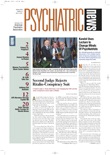Communicating with and perhaps conducting therapy using the World Wide Web could afford psychiatrists the ability to reach out to patients who would never have had access to or sought out mental health services utilizing more traditional methods. The potential for the practice of “e-psychiatry” to help scores of these patients is staggering—but so are the pitfalls. For example, how do you handle the e-mail that shows up in your e-mailbox from a suicidal patient while you are away from the office?
“There are clearly ways in which technology will benefit our patients and enrich our professional lives,” said Ronnie S. Stangler, M.D., at APA’s 2001 annual meeting in New Orleans last month. “There are also clearly major conflicts, risks, and potential misuses.”
Perhaps the advantages of practicing Web-based psychiatry are theoretical, perhaps they are real, but the field doesn’t yet have the answers, continued Stangler, a professor of psychiatry at the University of Washington and a member of APA’s Committee on Information Technology. However, those who express an interest in pursuing e-psychiatry believe that the potential advantages include anytime/anyplace availability, accessibility, flexibility, convenience, and partial anonymity, just to name a few, she noted.
Technology, said Stangler, may allow psychiatry the opportunity to do “something different, to offer experiences in therapeutic intervention that are truly different from what we know and do today.” While the medium is only a tool, Stangler emphasized, in the end it can create novel possibilities.
To navigate the realm of Web-based practice, however, psychiatrists need to understand a broad range of issues raised by its use, including issues surrounding quality of care; privacy and confidentiality; impact on the physician-patient relationship; and challenges to licensure, regulation, and certification requirements brought on by the Web’s ability to easily, and perhaps unknowingly, cross jurisdictional boundaries.
Unfortunately, said Stangler, there are no comprehensive, clear guidelines yet for the practice of e-psychiatry. There are limited resources available, including recommendations by the AMA on such specifics as e-mail communications with patients and brief guidelines from the American Medical Informatics Association (AMIA) and the Psychiatric Society for Informatics (PSI). As Web-based technologies continue to evolve, so will psychiatry’s involvement with Internet practice, Stangler predicted.
Tomorrow Already Here
The practice of medicine today already includes extensive Web-based activity, according to Nicolas P. Terry, LL.M., a professor of law and codirector of the Center for Health Law Studies at St. Louis University. “Syndication of publications; CME activities; services such as Medem.com, which offer business-to-business (or ‘B to B’) services to construct for physicians a business-to-consumer (or ‘B to C’) interface; procurement activities; and portals of information such as Medscape.com, are very active and vital parts of internet based healthcare today.” Not to mention, Terry said, all the “background” activities of processing of paperwork, including electronic processing of patient records and insurance claims.
According to Terry, the possibilities of electronic communication are endless. For example, technology will one day allow people at home to walk into their bathroom in the morning and, instead of simply stepping on a scale to check their weight, interact with an integrated system with a permanent online connection. The new device will give them a complete checkup, Terry predicted, and transmit the data to a physician database. By lunchtime, people will have received e-mail via their personal organizers that tells them what they can eat for lunch.
“If it seems far-fetched, folks, the technology already exists,” Terry concluded. “Its wide availability depends only upon increasing 24-hour-a-day, seven-day-a-week broadband access to each person’s home. A little-known company called Panasonic is currently conducting clinical trials on machines that can interface with a doctor module and provide just these types of services.”
With regard to e-psychiatry, Terry said to “keep your eye on telepsychiatry and Web help.” Videoconferencing already allows remote sessions to occur, and soon Web-based counseling and therapy will be common, he said.
Legal, Ethical Pitfalls
With the rapidly advancing technologies in the next few decades come significant legal and ethical challenges, Terry said.
The most important legal questions will surround licensure and jurisdiction. For example, will doctors be able to practice across state lines using the new technologies? “Secondly, the idea of malpractice will have to not only be expanded but also perhaps totally redefined.”
“The real key here is that the patient-physician relationship will totally change,” Terry suggested. “E-health will deliver information, diagnosis, treatment, care, and prescribing in a nonlinear, nonhierarchical way. It will allow patients to enter the mental health system at far more points than they’ve ever been allowed to before. And that mode of entry and creation of new relationships basically does an end-run around most of the regulatory systems that we’ve set up over the past 200 years.”
More information on the practice of e-psychiatry is posted on the PSI Web site at www.psychinformatics.org. General e-medicine information is posted on the AMIA Web site at www.amia.org. ▪

